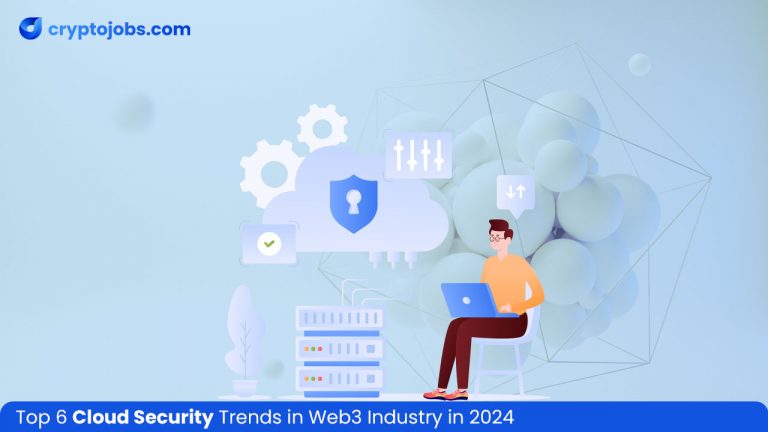
Top 6 Cloud Security Trends in the Web3 Industry in 2024
- cryptojobs.com
- April 8, 2024
- All Posts, Career Guide
- Web3
- 0 Comments
Did you know businesses are forecasted to spend a whopping $1 trillion this year on cloud computing infrastructure? This amount has escalated due to numerous factors, such as the release of multiple new platforms, service offerings, and the use of artificial intelligence (AI). Web3 has further transformed the cloud security job market, adding decentralized models that promise security, efficiency, and greater collaboration.
The tough ongoing competition among thousands of businesses has led them to look beyond the usual time—and money-saving opportunities when it comes to cloud security. Contemporary cybersecurity is repeatedly plagued with new issues, which presents a substantial challenge for security teams and IT professionals.
However, despite the emerging threats, cloud security remains a top priority for most organizations. This is no surprise as the threats are ever-evolving, but the Web3 industry carries the most sensitive information about thousands of customers needing the utmost protection.
To address these recent issues, the professionals have come up with 6 top cloud security trends that aim to maintain security. However, before we take a look at these trends, let us introduce you to a few essential concepts.
Check out: Practical Steps for Starting a Career in Web3 Cloud Security for Beginners
The Modern Phenomenon of Cloud Security
What is Cloud Security?
Cloud security is a platform that combines numerous technologies, procedures, policies, and controls invented to safeguard applications, environments, and cloud data from all types of security threats and vulnerabilities.
It involves governance, compliance, DR/BC planning, identity and access management, data security, and availability for most industries. Web3 cloud security models are designed to protect online networks and cloud data from external and internal cloud security threats, access management, and data governance.
As more organizations incorporate digital transformation strategies and cloud-based tools, the essence of cloud security increases. Along with safeguarding data, cybersecurity also helps companies maintain customers’ privacy and comply with regulatory requirements.
Unlike traditional security configurations, cybersecurity can be modified to any organization’s requirements. This allows stakeholders and security personnel to focus on other aspects of the business instead of diverting all attention to cloud security only. This involves threat detection, network security, and data protection.
What is the Current State of Cloud Security?
Industries are more focused on cloud security than ever. Cloud service teams no longer consider it a discrete practice but something they showcase, ensuring that their customers know it is among their primary principles. From small to large-scale organizations, it is a top aspect of data protection strategies and overall security practices.
Web3, modern technologies, AI, and automation have significantly advanced cybersecurity, enabling it to deal with more complex security issues. Entire companies dedicated to cybersecurity have emerged because mere in-house cloud security does not suffice for progressive threats. These organizations offer top cloud security solutions, keeping them ahead of potential vulnerabilities and attacks.
Despite the modern technological and automation developments in cybersecurity, Sophos reports that organizations are facing a 56% increase in attacks and a 59% increase in the complexity of these viruses. Moreover, around 67% of the SMBs’ operations have already been hampered by some ransomware.
The cloud security giants, which house exceptional IT and security professionals, are making tremendous efforts to invent new ways to combat these attacks. They are working on automation technologies that effectively mitigate all types of security risks.
Check out: 6 Highest-Paying Web3 Cloud Security Architect Jobs in 2024
Top 6 Cloud Security Trends in the Web3 Industry in 2024
With the emerging critical attacks, adapting to the latest security trends in the Web3 industry is imperative. Take a look at these top six trends you can incorporate into your business to maintain top-notch security:
Zero Trust Model
The zero-trust model indicates that companies verify everything before communicating with it in any way, regardless of whether it is an external or internal file. All organizations shifting to the cloud must apply this zero-trust model in all businesses and transactions to establish security. This will allow only genuine users and services to work with the companies’ resources and data in the Web3 landscape.
The zero-trust platform aims to strengthen the security infrastructure, reducing the probability of an attack and curbing many of them. Unlike classic security checks, this platform allows the concerned team to run everything through thorough verification processes.
Secure Access Service Edge
The Secure Access Service Edge, or SASE, combines network security and cloud security service principles. It is ideal for modern organizations as it combines WAN capabilities with various security features, creating a robust environment within the cloud management system.
Several companies are hoping to join the SASE trend, as it boasts excellent security management and strengthens existing security measures. It also allows authorized personnel to access user data from all locations and devices.
Cybersecurity Mesh
A new-age Web3 cloud security trend is the cybersecurity mesh, currently being utilized by companies worldwide. The concept secures each user with their devices in only the cloud infrastructure, as opposed to the whole network.
This approach is ideal for the work-from-home or remote work culture as Cybersecurity Mesh revolves around creating a distributed cyber network and infrastructure. With this security trend, you can control and manage all types of stored data and implement appropriate security policies.
Automation of DevSecOps
An increasing number of organizations are using the DevSecOps automation methodology as it mitigates the issue even before it makes an impact. Among its most significant benefits is that DevSecOps allows you to integrate security throughout the application development process.
The automation of DevSecOps enables you to implement automatic security check processes without anyone having to do it manually in the development phase. It is a high success rate in the organizations running on fully automated applications. The ability of DevSecOps to work with all app development steps allows it to secure all layers.
Please note that to incorporate DevSecOps, the security, and DevSecOps professionals need to collaborate. Applying this methodology is a continuous process through the CI/CD pipeline as apps undergo upgrades and fixes.
Artificial Intelligence and Machine Learning as Cloud Security
As expected, AI and Machine Learning (ML) can also be incorporated into the Web3 cloud security infrastructure. You can automate several processes using these systems and find quick and effective solutions to even complicated technical problems.
AI and ML can analyze and filter data in the cloud infrastructure, identifying malicious patterns and triggering appropriate alerts. Advanced security solutions can also be combined to leverage AI and ML to respond to threats in a timely manner and maintain a solid security posture.
Cloud-Native Platform and Tools
The need for cloud security is progressive, leading to the perpetual release of robust security tools that protect all types of businesses and applications. Organizations are going beyond the typical safety platforms, investing in the latest Cloud-Security platforms experts offer.
These tools, such as the CSPM and CWPP, provide comprehensive security and are constantly updated to handle newly coded viruses. Security professionals suggest investing in these tools to better handle sensitive customer data.
The Best Cloud Security Best Practices
Apart from investing in the top six cloud security trends, you can also utilize the following cloud security practices:
- Protection of data storage containers.
- Understanding the security models for maximum benefits.
- Defining cloud security policies.
- Comprehensive security posture visibility.
- Implementing modern security concepts like cloud intelligence, forensics, and threat hunting.
- Managing user access.
- Managing misconfigurations.
- Carrying out extensive cybersecurity training.
Finding Web3 jobs in the competitive Web3 space can be stress-free with cryptojobs.com, as top Web3 and crypto companies trust the platform for hiring the best talent. Start your job search today and find a position that matches your skillset.




